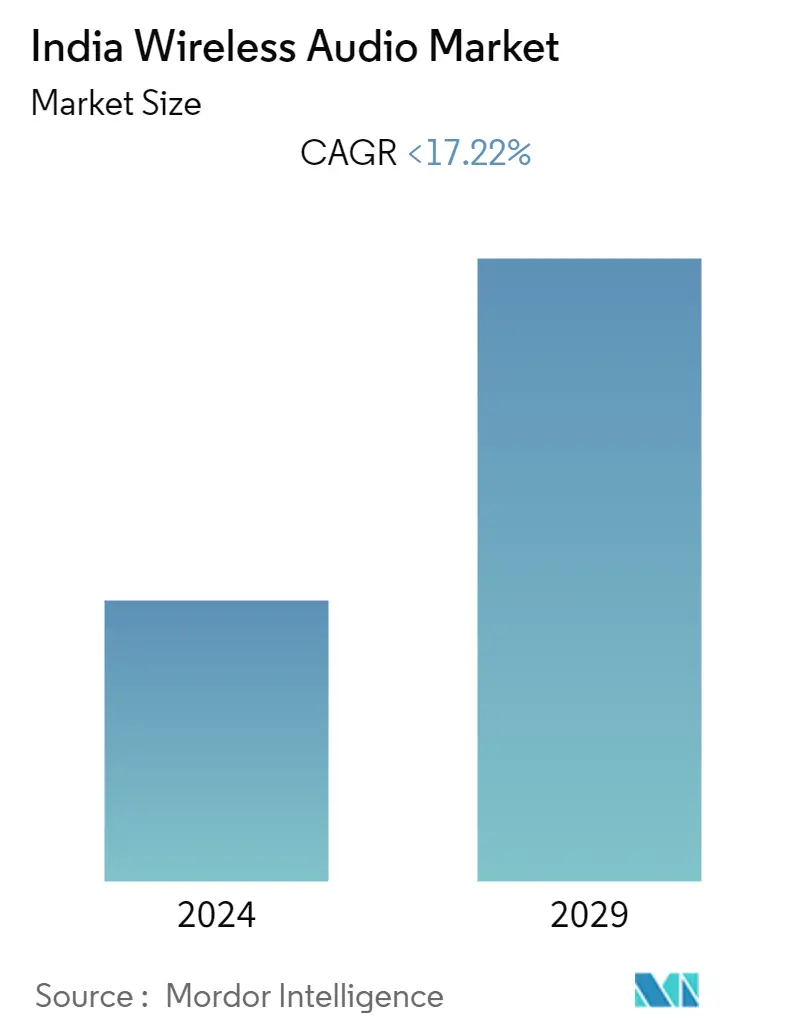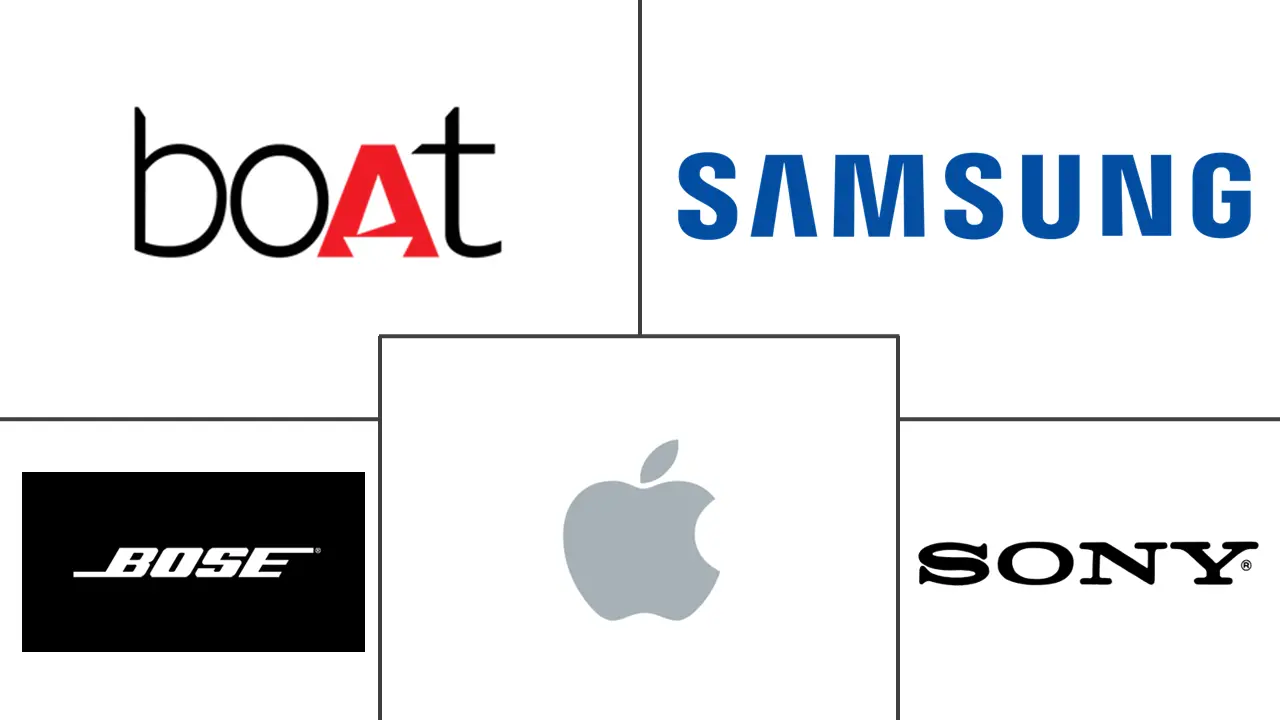Market Size of India Wireless Audio Industry

| Study Period | 2019 - 2029 |
| Base Year For Estimation | 2023 |
| Forecast Data Period | 2024 - 2029 |
| Historical Data Period | 2019 - 2022 |
| CAGR | < 17.22 % |
| Market Concentration | Low |
Major Players
*Disclaimer: Major Players sorted in no particular order |
India Wireless Audio Market Analysis
The India wireless audio market is expected to register a CAGR of approximately 17.22% throughout the forecast period. Some of the factors boosting market growth include higher smartphone penetration, reduced internet connection pricing, an increased need for mobility and flexibility, and a faster rate of technological development and acceptance.
- The primary driving components of the industry include the growing prevalence of entertainment devices, especially among the younger population; increasing usage of portable devices; and expanding implementations of wireless audio equipment in the business sector, such as events, exhibitions, contact centers, and others. Rapid technical improvement and a rising requirement for comfort among customers, including ease of mobility and distant accessibility, will create a considerable potential for industry participants over the forecast period.
- Consumers are turning to wireless audio equipment with the emergence of wireless innovations, including Bluetooth and Wi-Fi. This continuous change has resulted in an upsurge in demand for earphones and headphones. Furthermore, these gadgets' easy functioning, dependable sound quality, and small shape are among the elements propelling the industry.
- Various market players are making significant product innovations and developments by integrating multiple technologies in the market with existing products or adding new products to the portfolio. For instance, in June 2022, Samsung Electronics launched its 2022 lineup of soundbars in India on World Music Day. The new product lineup has seven new soundbars, including two series, the S-series and Q-series, both with Dolby Atmos. While the Samsung Q-series sound bars are made for Neo QLED and OLED TVs, the S-series comes with built-in Alexa support, DTS Virtual: X-Audio, and Dolby Atmos.
- The frequency spectrum of audio equipment is subject to stringent regulatory controls. Furthermore, using these gadgets at a volume higher than 85 decibels (dB) for 8 hours or longer may impair users' hearing abilities. These issues limit the market's progress. Additionally, the price sensitivity of Indian consumers is also among the challenging factors, as wireless audio devices usually come at a premium price compared to their wired counterparts.
- The COVID-19 outbreak resulted in stringent lockdowns, requiring individuals to stay home. This had a positive impact on the growth of the studied market as the use of audio equipment for home entertainment expanded significantly. As wireless audio devices are portable and can be used while carrying out any activity, such trends are expected to continue during the forecast period as well. Furthermore, the rise in the demand for video streaming via the internet and the acceptance of distant working, remote learning, and home workouts also raised the need for wireless audio equipment.
India Wireless Audio Industry Segmentation
A wireless audio system provides connection, flexibility, expandability, and convenience. These wireless audio devices transmit audio from audio-enabled gadgets to wireless output systems using a variety of wireless technologies, including Bluetooth, Wi-Fi, infrared, radio frequency, SKAA, and AirPlay.
The Indian wireless audio market provides an in-depth analysis of the market by tracking demand, technological trends, and recent developments in the market. The study segments the market based on product type (wireless earphones, wireless headphones, truly wireless earbuds, wireless soundbars, wireless speakers) and distribution channel (online and offline). The study also provides a detailed analysis of COVID-19's impact on the Indian wireless audio market. The market sizes and forecasts are provided in terms of value (USD million) for all the above segments.
| By Product Type | |
| Wireless Earphones | |
| Wireless Headphones | |
| Truly Wireless Earbuds |
| By Distribution Channel | |
| Online | |
| Offline |
India Wireless Audio Market Size Summary
The India wireless audio market is poised for significant growth, driven by factors such as increased smartphone penetration, affordable internet connectivity, and a rising demand for mobility and flexibility. The market is characterized by the growing popularity of entertainment devices among the youth, the widespread use of portable devices, and the expanding adoption of wireless audio equipment in various business sectors. Technological advancements and the need for convenience, including ease of mobility and remote accessibility, are creating substantial opportunities for industry players. The shift towards wireless innovations like Bluetooth and Wi-Fi has led to a surge in demand for earphones and headphones, with their user-friendly operation, reliable sound quality, and compact design further fueling market expansion.
The Indian e-commerce industry's growth has significantly influenced the wireless audio market, enabling consumers to access detailed product specifications and user feedback, thereby facilitating informed purchasing decisions. The availability of home delivery and flexible payment options has broadened the customer base for these devices. The increasing internet user base, supported by low data costs and initiatives like the "Digital India" campaign, is a key driver of market growth. The compatibility of wireless audio devices with smartphones, along with technological improvements such as active noise cancellation and appealing designs, is expected to boost market segments. The market is highly fragmented, with major players like Imagine Marketing Limited, Samsung, Apple Inc., Sony India, and Bose Corporation employing strategies like product launches and innovations to capture market share.
India Wireless Audio Market Size - Table of Contents
-
1. MARKET INSIGHTS
-
1.1 Market Overview
-
1.2 Industry Attractiveness - Porter's Five Forces Analysis
-
1.2.1 Bargaining Power of Suppliers
-
1.2.2 Bargaining Power of Buyer
-
1.2.3 Threat of New Entrants
-
1.2.4 Threat of Substitute Products
-
1.2.5 Intensity of Competitive Rivalry
-
-
1.3 Industry Supply Chain Analysis
-
1.4 Assesment of the impact of COVID-19 on the Industry
-
-
2. MARKET SEGMENTATION
-
2.1 By Product Type
-
2.1.1 Wireless Earphones
-
2.1.2 Wireless Headphones
-
2.1.3 Truly Wireless Earbuds
-
-
2.2 By Distribution Channel
-
2.2.1 Online
-
2.2.2 Offline
-
-
India Wireless Audio Market Size FAQs
What is the current India Wireless Audio Market size?
The India Wireless Audio Market is projected to register a CAGR of less than 17.22% during the forecast period (2024-2029)
Who are the key players in India Wireless Audio Market?
Imagine Marketing Limited (boat LIFESTYLE), Apple Inc., Sony India, Bose Corporation and Samsung Electronics Co. Ltd. are the major companies operating in the India Wireless Audio Market.

